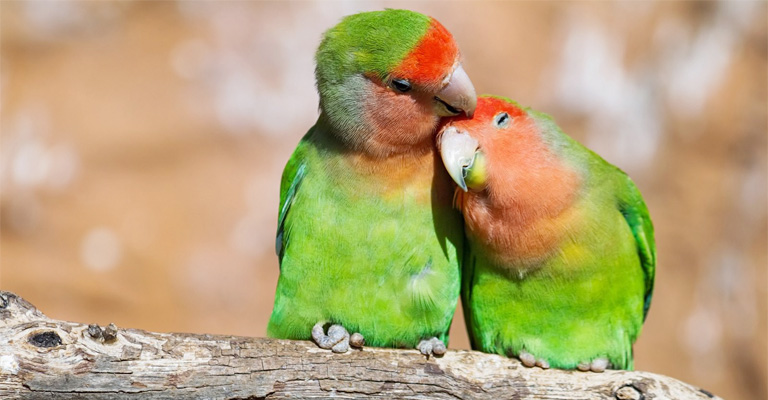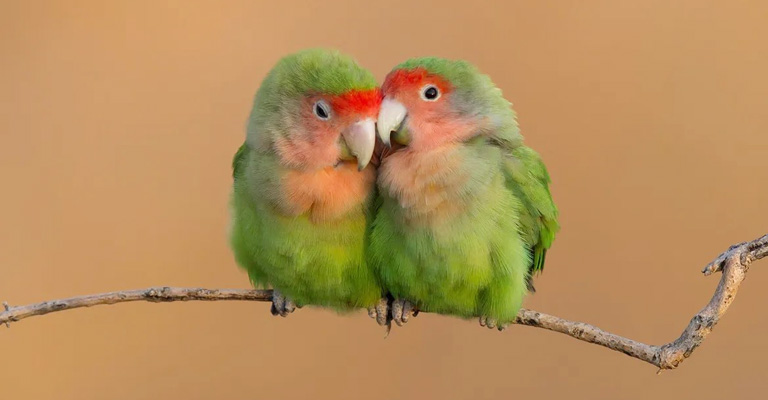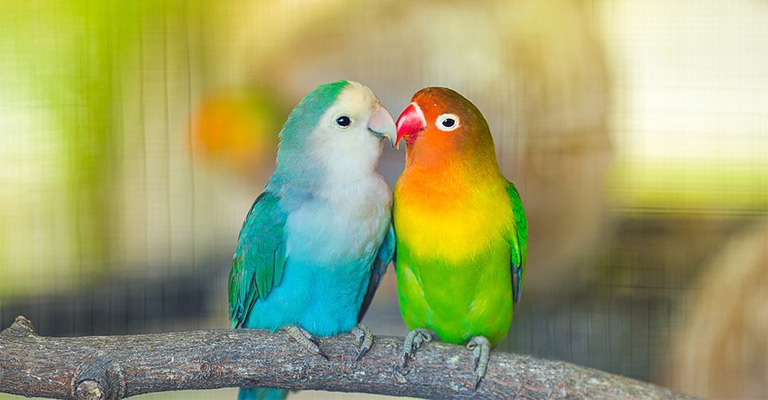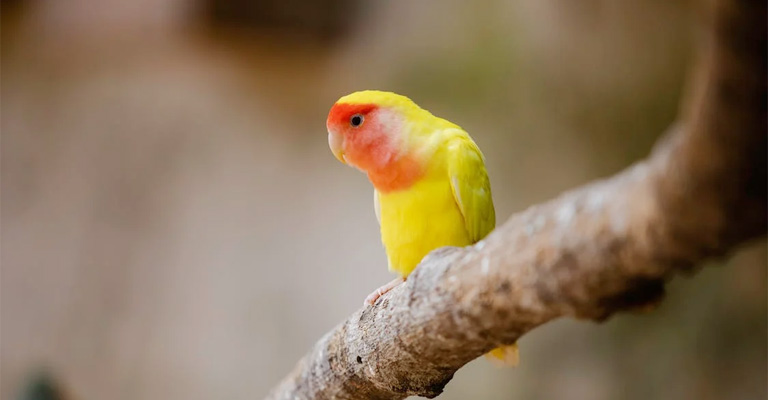The captivating world of lovebirds, with their vibrant plumage and affectionate demeanor, has enamored bird enthusiasts for centuries.
Yet, behind their charming facade lies an intriguing question that has often perplexed avian enthusiasts and pet owners: Do Lovebirds Need to Be in Pairs- what is the reasons?
These small parrots are renowned for their strong social bonds and monogamous nature, often forming deep connections with their chosen mates.
However, understanding the reasons behind their preference for companionship or solitude is essential for their well-being in both the wild and captivity.
In this exploration, we will delve into the captivating world of lovebirds and dissect the compelling reasons behind their tendency to live in pairs or thrive individually.
From the intricate dynamics of their social lives to the benefits of companionship, we aim to uncover the secrets of these charming avian companions.

Do Lovebirds Need To Be In Pairs- What Are The Reasons?
Lovebirds are known for forming strong social bonds, and while it’s not an absolute necessity for them to be in pairs, there are several reasons why having a mate or companion is highly beneficial for their well-being:
Social Interaction
Lovebirds are highly social birds by nature. Having a mate allows them to engage in social activities, which are essential for their mental and emotional stimulation. Interaction with a mate helps prevent loneliness and boredom.
Emotional Support
Lovebirds form deep emotional connections with their partners. Having a mate provides emotional support, reducing stress and anxiety. Separation from a mate can lead to depression and a decline in mental health.
Companionship
Lovebirds are naturally monogamous, and in the wild, they spend a significant amount of time together. In captivity, having a companion mirrors their natural behavior and provides a sense of companionship and security.
Communication
Lovebirds communicate with each other through vocalizations, preening, and physical contact. Having a mate allows them to express themselves and share their feelings, which is crucial for their overall well-being.
Behavioral Balance
Lovebirds often exhibit aggressive or territorial behavior when kept alone, which can be challenging for both the bird and its owner. With a mate, these behaviors are typically directed toward their partner, and they are less likely to develop behavioral issues.
Reproduction
If you’re interested in breeding lovebirds, having a pair is essential. Lovebirds that are kept in pairs are more likely to engage in courtship and nesting behaviors, leading to the potential for raising offspring.
Longer Lifespan
Lovebirds that are kept in pairs tend to live longer and healthier lives. Emotional support, reduced stress, and the ability to engage in natural social behaviors contribute to their overall well-being and longevity.
While it’s possible to keep a single lovebird, it requires more attention and interaction from their human caregiver to ensure they receive the social stimulation and companionship they need.
However, for the most fulfilling and emotionally balanced life, many experts recommend keeping lovebirds in pairs to mimic their natural behavior and ensure their overall happiness and well-being.
Why Do Love Birds Always Live In Pairs?

Lovebirds are renowned for their strong preference for living in pairs, and this behavior is deeply ingrained in their natural instincts. Here are some reasons why lovebirds tend to live in pairs:
Monogamous Nature
Lovebirds are naturally monogamous birds. In the wild, they form strong and lasting bonds with a single mate, and this monogamous behavior extends to captive lovebirds.
They are known for their deep emotional connections and are often seen preening, cuddling, and feeding each other.
Social Interaction
Lovebirds thrive on social interaction. They engage in various bonding activities with their mates, such as mutual grooming, sharing food, and vocalizing together. These interactions provide mental stimulation and emotional support, helping to maintain their overall well-being.
Emotional Stability
Pair-bonded lovebirds experience emotional stability. Having a constant companion reduces stress and loneliness, leading to a happier and more contented disposition. In contrast, solitary lovebirds may exhibit signs of depression or anxiety.
Security and Safety
In the wild, lovebirds find safety in numbers. Being in a pair provides a sense of security, as they can watch out for each other and help protect their nest and territory. In captivity, this innate need for security persists.
Reproductive Behavior
Lovebirds in pairs are more likely to exhibit natural courtship and reproductive behaviors. This includes building nests, laying eggs, and raising chicks. For those interested in breeding lovebirds, having a pair is essential for successful reproduction.
Reduced Aggression
Solitary lovebirds can become territorial and may exhibit aggressive behaviors towards humans or other birds. When they have a mate, these aggressive tendencies are often redirected towards their partner, reducing potential harm to other birds or humans.
Longevity and Happiness
Lovebirds kept in pairs often lead longer, healthier lives. The emotional support and reduced stress associated with a mate contribute to their overall happiness and well-being, which can extend their lifespan.
While lovebirds are highly adaptable and can form bonds with their human caregivers if kept alone, they generally thrive best when they can maintain their natural social and emotional connections by living in pairs.
Pair-bonded lovebirds can lead fulfilling lives full of affection, companionship, and shared experiences, both in the wild and in captivity.
How Do We Know If A Male Or A Female Lovebird Is Better?

Determining whether a male or female lovebird is better for you depends on your specific preferences and goals as a pet owner. Both genders can make wonderful companions, but they may exhibit different behaviors and characteristics.
Here are some tips to help you decide:
Consider Personality
Male and female lovebirds can have varying personality traits. Males are often described as more outgoing, playful, and vocal, while females tend to be calmer and may exhibit more nurturing behaviors.
Consider which personality traits align better with your own preferences.
Noise Level
Male lovebirds are typically noisier, as they often engage in more vocalizations and mimicry. If you live in a quiet environment or have noise-sensitive neighbors, you might prefer a female lovebird for their generally quieter demeanor.
Color Variations
Some lovebird species, such as the Fischer’s lovebird, exhibit sexual dimorphism in coloration, with males having more vibrant plumage. If you have a specific color preference, you may want to choose a gender that displays the colors you find most appealing.
Breeding Considerations
If you intend to breed lovebirds, you’ll need both a male and a female. Research the specific species you’re interested in to understand their breeding behaviors and requirements.
Compatibility
If you already have one lovebird and wish to add a companion, consider the gender of your existing bird. Compatibility can vary, but opposite-sex pairings are generally more likely to get along harmoniously.
Solo or Bonded Pair
Some owners prefer to have a single lovebird as a pet, while others enjoy the companionship of a bonded pair. Consider whether you want to maintain a solitary pet or create a social dynamic between two birds.
Training and Taming
Both male and female lovebirds can be trained and tamed with patience and dedication. Consider your willingness and ability to invest time and effort into training and socializing your pet, regardless of their gender.
Ultimately, the decision between a male or female lovebird depends on your personal preferences and the dynamics you want in your avian companion(s).
Spend time with both genders to get a sense of their individual personalities, and choose the one that best aligns with your lifestyle and goals as a bird owner.
What Should I Do To Make A Single Lovebird Happy?

Ensuring the happiness of a single lovebird requires attention, affection, and creating an environment that fulfills their social and mental needs. Here are some gestures you can make to keep your single lovebird happy:
Daily Interaction and Playtime
Spend quality time with your lovebird every day. Interact, talk, and engage in gentle play. Lovebirds thrive on social interaction, and your attention is crucial to their emotional well-being.
Provide toys, puzzles, and activities to keep them mentally stimulated, preventing boredom.
Provide a Variety of Toys
Offer a diverse range of toys, such as chew toys, puzzle feeders, and swings. Rotate the toys regularly to keep their environment engaging and prevent monotony.
Toys provide mental and physical stimulation, preventing behavioral problems and promoting happiness.
Create a Stimulating Environment
Arrange their cage in an enriching way. Add perches, ropes, and different levels to encourage movement and exploration. Provide natural branches for them to chew on, promoting both physical exercise and mental engagement.
Offer a Balanced Diet
Ensure your lovebird’s diet is nutritious and varied. Provide a mix of high-quality pellets, fresh fruits, vegetables, and occasional treats. A balanced diet is essential for their overall health, energy levels, and happiness.
Establish a Routine
Lovebirds thrive on routine and predictability. Maintain a consistent daily schedule for feeding, playtime, and bedtime. Predictable routines make them feel secure and reduce stress, contributing to their contentment.
Music and Environmental Enrichment
Play soft, soothing music or nature sounds when you’re not around. Birds respond well to auditory stimulation. Additionally, provides visual enrichment, such as a window view of outdoor activities, so your lovebird can observe the changing environment.
Regular Health Check-ups
Schedule regular visits to an avian veterinarian. Preventive healthcare ensures your lovebird is in good physical condition. Addressing health issues promptly is crucial for their happiness, as illness or discomfort can lead to stress and unhappiness.
By incorporating these gestures into your lovebird’s daily life, you can create a happy and fulfilling environment for your single pet. Your love, attention, and dedication to their well-being are the keys to their happiness and harmonious companionship.
FAQs
Do Lovebirds Absolutely Need a Partner to Be Happy?
Lovebirds are social birds that thrive on companionship, but it’s not an absolute requirement for happiness. Some lovebirds can be content as single pets with dedicated human companionship. However, they do need social interaction and mental stimulation, so if you keep a single lovebird, ensure you spend quality time with them daily.
Why Do Lovebirds Prefer Being in Pairs?
Lovebirds naturally form strong social bonds with their chosen mates in the wild. This behavior has evolved as a survival strategy, offering protection, companionship, and emotional support.
In captivity, their preference for pairs or small flocks mirrors their instinctual need for social interaction and emotional well-being.
Can a Single Lovebird Be Lonely?
Yes, a single lovebird can experience loneliness. These birds thrive on social interaction, and without a mate or dedicated human companion, they may become bored and depressed. Loneliness in lovebirds can lead to behavioral issues and a decline in overall well-being.
Are There Benefits to Keeping Lovebirds in Pairs?
Yes, there are several benefits to keeping lovebirds in pairs. These include emotional support, reduced stress, companionship, and the opportunity to engage in natural social behaviors, such as grooming and vocalizing. Pairs can also provide mental stimulation and prevent loneliness.
Can Lovebirds Be Kept Alone Happily with Human Interaction?
Yes, lovebirds can be kept alone and remain happy if they receive sufficient human interaction, attention, and mental stimulation. Building a strong bond with your single lovebird, offering toys and social playtime, and maintaining a consistent routine can help ensure their happiness as a solitary pet.
However, it’s essential to dedicate time and effort to meet their social and emotional needs.
Conclusion
In the realm of lovebirds, the question of whether they need to be in pairs boils down to the intrinsic nature of these affectionate creatures.
While lovebirds can indeed thrive individually, the reasons behind their preference for companionship are deeply rooted in their social and emotional well-being.
The benefits of having a mate, including emotional support, social interaction, and shared experiences, are vital for their happiness. However, it’s essential to remember that the needs and preferences of individual lovebirds can vary.
Some may thrive in pairs, while others may form strong bonds with their human caregivers.
Ultimately, the key is to provide lovebirds with a nurturing and stimulating environment that addresses their unique needs, ensuring a contented and fulfilling life for these charming feathered friends.
Meta